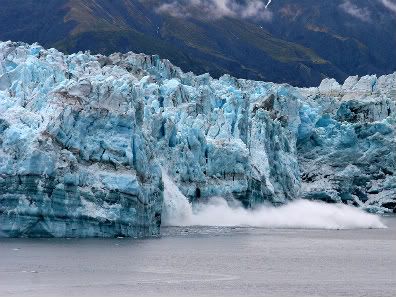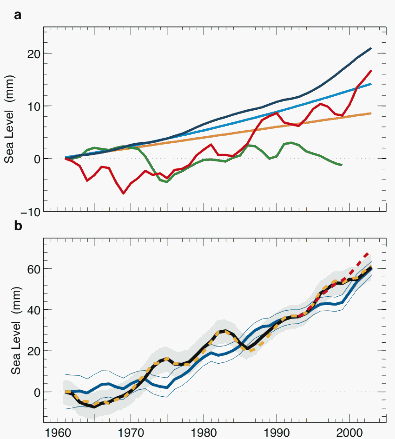Ocean temperatures and sea level increases 50 percent higher than previously estimated

An international team of researchers compared climate models with improved observations that show sea levels rose by 1.5 millimeters per year in the period from 1961-2003. That equates to an approximately 6.3 centimeters (2½-inch) increase in ocean levels in a 42-year span.
The ocean warming and thermal expansion rates are more than 50 percent larger than previous estimates for the upper 300 meters of oceans.
The research corrected for small but systematic biases recently discovered in the global ocean observing system, and uses statistical techniques that “infill” information in data-sparse regions. The results increase scientists’ confidence in ocean observations and further demonstrate that climate models simulate ocean temperature variability more realistically than previously thought.
This is important for the climate modeling community because it demonstrates that the climate models used for assessing sea-level rise and ocean warming tie in closely with the observed results. - Peter Gleckler, Lawrence Livermore National Laboratory climate scientist
Estimates of ocean heat content and sea surface temperature. Upper: Comparison of our upper-ocean heat content with previous estimates (red1 and blue12) for the upper 700 m. The straight lines are linear fits to the estimates. The global mean stratospheric optical depth(arbitrary scale) at the bottom indicates the timing of major volcanic eruptions. The brown curve is a three-year running average of these values, included for comparison with the smoothed observations. Lower: Comparison of thick black line, as in a with the thick red line; thin red lines indicate estimates of one standard deviation error) results with sea surface temperature (blue; right-hand scale). All time series were smoothed with a three-year running average and are relative to 1961.
Climate model data were analyzed from 13 different modeling groups. All model data were obtained from the WCRP CMIP3 multi-model dataset archived at the Lawrence Livermore National Laboratory's (LLNL) Program for Climate Model Diagnosis and Intercomparison (PCMDI).
Although observations and models confirm that recent warming is greatest in the upper ocean, there are widespread observations of warming deeper than 700 meters:
 energy :: sustainability :: biomass :: bioenergy :: renewables :: fossil fuels :: ocean temperatures :: sea level :: glaciers :: ice sheet :: climate change :: climate model ::
energy :: sustainability :: biomass :: bioenergy :: renewables :: fossil fuels :: ocean temperatures :: sea level :: glaciers :: ice sheet :: climate change :: climate model :: Results were compared with recent estimates of other contributions to sea-level rise including glaciers, ice caps, Greenland and Antarctic ice sheets, and thermal expansion changes in the deep ocean. When these independent lines of evidence are examined collectively, the story is more consistent than found in earlier studies.
The oceans store more than 90 percent of the heat in the Earth’s climate system and act as a temporary buffer against the effects of climate change. The ocean warming and thermal expansion rates are 50 percent larger than previous estimates for the upper 700 meters of oceans, and greater than that for the upper 300 meters.
This is just the tip of the iceberg, so to speak. Our ability to quantify structural uncertainties in observationally based estimates is critically important. This study represents important progress. - Peter GlecklerThe team involved researchers from the Centre for Australian Weather and Climate Research (CSIRO), the Antarctic Climate and Ecosystems Cooperative Research Centre and LLNL.
Image: Rising ocean and atmospheric temperatures affect glaciers such as Alaska's Hubbard Glacier. Photo by Bob Hirschfeld.
Graph, courtesy of LLNL.
References:
Catia M. Domingues, John A. Church, Neil J. White, Peter J. Gleckler, Susan E. Wijffels, Paul M. Barker & Jeff R. Dunn. "Improved estimates of upper-ocean warming and multi-decadal sea-level rise", Nature 453, 1090-1093 (19 June 2008) | doi:10.1038/nature07080
Article continues
 --------------
--------------
 Mongabay, a leading resource for news and perspectives on environmental and conservation issues related to the tropics, has launched Tropical Conservation Science - a new, open access academic e-journal. It will cover a wide variety of scientific and social studies on tropical ecosystems, their biodiversity and the threats posed to them.
Mongabay, a leading resource for news and perspectives on environmental and conservation issues related to the tropics, has launched Tropical Conservation Science - a new, open access academic e-journal. It will cover a wide variety of scientific and social studies on tropical ecosystems, their biodiversity and the threats posed to them.










Thursday, June 19, 2008
Geotimes focuses on the biochar revolution
This second video offers a very good, longer introduction to 'terra preta' and its modern variant known as biochar. It was made by ABC News in Australia, where the concept is making serious head way.
It seems like the idea to use soils as carbon sinks - by putting biochar obtained from the production of carbon-negative energy into them -, is rapidly becoming one of the winning technologies with which to combat climate change. One advocate of the concept of biochar is NASA's Dr James Hansen, who says we need to implement it in order to put humanity on track to reach a goal of reducing atmospheric CO2 levels from today's 387ppm to 350ppm (previous post).
One of the organisations testing the concept is the Biochar Fund. It studies the application of biochar at the tropical forest frontier, because it is there where it may yield many additional benefits - from ending rural poverty, and slowing deforestation, to reducing hunger and putting an end to energy poverty.
Article continues
posted by Biopact team at 8:24 PM 2 comments links to this post
